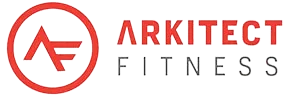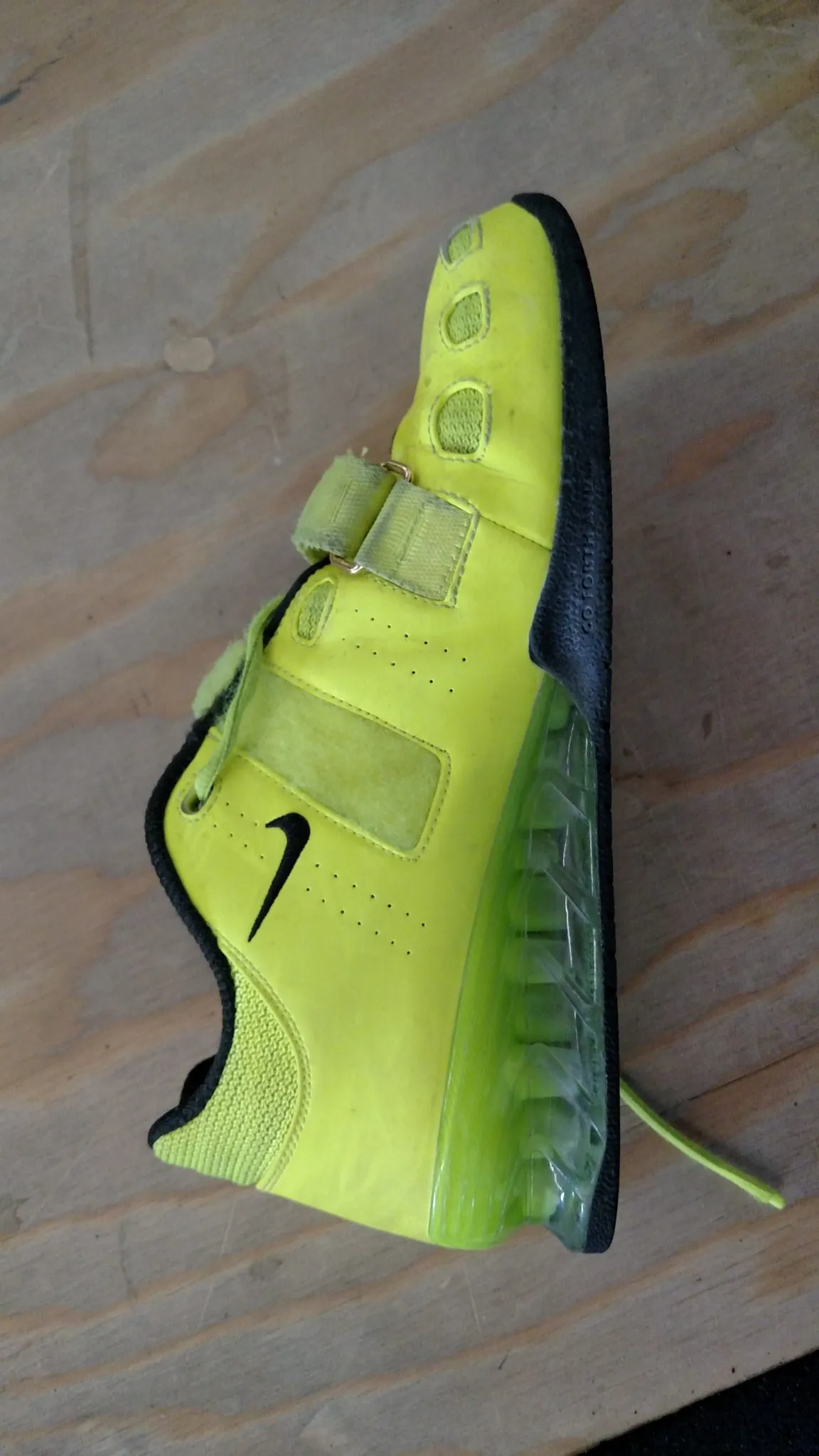Our gym is home to a wide variety of clientele, from pregnant women working to minimize their weight gain and have a safe and healthy delivery, to national level medalists in the sport of Weightlifting. Our custom programs are tailored to any goal, but the backbone of all of our programs is strength training. Strength, while not the only aspect of fitness, is arguably the most important. Because running is the most popular form of fitness in the US, most people come in to exercise with their running or cross training shoes. It doesn’t take long to realize on a strength training program that a running shoe isn’t exactly appropriate. When our clients see ladies in our gym throwing around hundreds of pounds with ease, they start to get curious about the special footwear they adorn. As they say, you have to have the right tool for the job, but Weightlifting shoes aren’t for everyone (or everything) in the gym.
What is a Weightlifting Shoe?
Technically speaking, a Weightlifting shoe has two distinct characteristics. First and foremost it has a raised heel.
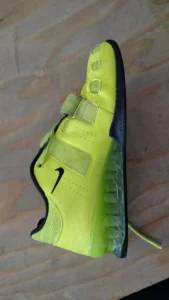
The Nike Romaleo II which has an “effective” heel height of .75″
In the sport of Weightlifting when you hold the bar over your head in a snatch, or on your chest in a clean or a front squat, it’s extremely important that your body and torso are very upright. If the torso is leaned forward, it’s nearly impossibly to hold any legitimate amount of weight over your head. In order to keep your torso vertical, your butt has to be under you, rather than behind you.
This pushes your knee forward in the squat, which requires quite a bit of ankle flexibility (dorsiflexion). The raised heel reduces the amount of dorsiflexion required to squat with your knees forward and your torso upright. the higher the heel the less dorsiflexion is needed. Sometimes the raised heel of a traditional Weightlifting shoe isn’t enough for certain athletes so they add additional lifts to the bottom of the shoe to give them even more height.
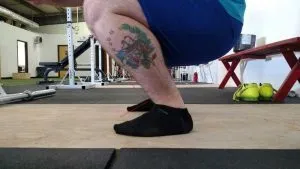

The second distinguishing quality of a Weightlifting shoe is its firm or hard sole. While running shoes are mention to have cushion to help absorb impact, you want the opposite in a Weightlifting shoe. Think about it: Is it easier to walk/jump standing on water bed, or a firm mattress? The same thing applies to a Weightlifting shoe. You’re trying to drive forcefully through the floor while you lift, thus you want something very stable. Most modern Weightlifting shoes are some type of composite, but old school Weightlifting shoes had wooden soles.
The last characteristic is that the bottom of a Weightlifting shoe is NOT contoured. That means there is maximum contact between your foot and the floor. Again this adds stability and maximizes power.

Do I Need a Weightlifting Shoe?
Yes, you do, because you should be doing some weight training! But seriously, there are times when Weightlifting shoes are crucial, times when they are optional, and times when they are completely inappropriate. In general, Weightlifting shoes are highly recommended when doing any stationary lifting. This would be when your feet are planted or have minimal movement while you hoist heavy loads. This would be things like: Squats, over head presses, push presses, kettlebell swings, etc…The only time we would consider Weightlifting shoes mandatory would be for the “classical lifts” which are the snatch and the clean & jerk; the two lifts contested in Weightlifting.
There are other exercises where a Weightlifting shoe is some what optional, and can be personal preference. Lunges, jumping exercises like box jumps, come to mind. Not necessary, but both exercises can benefit from getting a good solid drive which the firm sole of a Weightlifting shoe will provide. Some people may prefer the cushion of a more traditional sneaker when doing a high impact exercise like a broad or box jump. Again, it can be personal preference. Deadlifts are a special case because it really depends on what your training goals are. While getting a solid drive into the floor is important on a deadlift, the raised heel of the shoe can make deadlifts harder because you have to pull the bar farther. I know what you’re thinking “does the heel of a Weightlifting shoe really make it noticeably harder?” The short answer to that question is: yes. The long answer is: have you ever been doing an exercise (like bench press) and you nearly made the lift, but came just an inch or so short, and you just couldn’t lock it out? Well, there you go. Especially in a max attempt, it could be make or break factor. If you were to watch a Powerlifting meet (where the squat, bench press, and deadlift are contested) you would see competitors wearing one of two things: Chuck Taylors, a favorite in the community because they are flat, almost like being barefoot, or “deadlift slippers” which are basically just glorified socks, because rules state you must be wearing footwear. Our Weightlifters on the other hand, do their deadlifts in their Weightlifitng shoes, because when they perform the snatch or clean (where the bar starts on the floor like a deadlift) they are wearing their shoes, so it makes sense for them to pull their deadlifts in the same fashion, with the shoes on. The heel height does change the dynamic of the lift.
When Should I NOT Wear a Weightlifting Shoe?
There are certainly instances when you should absolutely not wear a Weightlifting shoe. This could include any traveling exercises, like farmers walks, yolk walks, crawl variations, etc…Also not a great idea for anything that doesn’t really use your full foot such as push-ups, planks, sprinting/running (obviously) sled pushes, lateral shuffles, etc…
It’s not uncommon to see our clients wearing Weightlifting shoes when they SHOULDN’T be, much to the chagrin of their coaches. The most common response we get after chiding them about it is “I was too lazy to change my shoes.” This is like a Triathlete wearing his wet suit on his bicycle ride because he was too lazy to change. We get it, it can be a pain in the @ss to switch shoes half way through your workout, but we are about doing what’s right, not what’s easy. If you’re lacking normal dorsiflexion, they can help in squats and some other exercises, but the shoe should be limited at all other times, as to not become a band-aid or crutch. It’s important to develop as much natural range of motion as possible. Stretching, and release techniques can be useful tools, but performing loaded exercises that take a joint through a full range of motion is crucial, and total ROM isn’t always met when wearing a shoe with a heel.
Which Weightlifting Shoe Should I Buy?
Traditionally there weren’t many options for Weightlifting shoes. In fact, Adidas were nearly the only option. Now, thanks to fitness trends like CrossFit, Weightlifting is becoming more popular, and the market is responding with many different brands and options available. With that said Adidas and Nike are still the “top dogs” in the field. Each brand has a flagship model, the Adipower, and the Romaleo, respectively. They cost a pretty penny clocking in at nearly $200, however if you take care of them, and only wear them when you’re supposed to, they can last upwards of 5 to maybe even 10 years! Almost every “less expensive” shoe I’ve purchased has only lasted a year, maybe a year and a half at most. It’s a “buy nice so you don’t buy twice” situation. I’m sure there are some less expensive options out there that will last, but I have no first hand experience with them. Even Adidas makes less expensive shoes, that are less than desirable, sometimes the heels aren’t as high, or the soles aren’t very hard and will compress under the load of a heavy squat. Perhaps a decent option for the casual trainee, but not recommended for anyone who is serious about training. Some viable options are:
Adidas Adipower
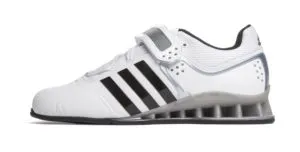
Nike Romaleo

Pendlay Weightlifitng Shoe
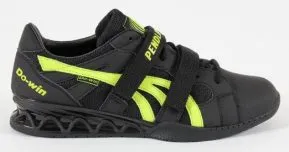
VS Athletics

Asics (tough to find, and usually expensive, but a great vintage look)
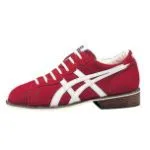
There are a lot of performance factors to consider when buying a Weightlifting shoe:
- Weight: When doing exercises like snatches and cleans, you want to be able to quickly move your feet. Heavier shoes will be sturdier, but you’ll sacrifice speed, and vice versa.
- Flex: Again, it’s about finding a good balance between flexible and sturdiness. For example the Adipowers have great flexibility, particularly in the toe box, but they don’t feel as planted as the Nikes do.
- Material: Old school shoes were leather with wooden soles. There are still shoes like that on the market. They are nice because they really mold to the shape of your foot, but they wear out quicker than the newer materials.
- Straps: Weightlifting shoes typically come with velcro straps to secure the laces (the last thing you want when throwing hundreds of pounds over your head is tripping on a shoe lace). Some shoes don’t have them, some only have one. Some straps aren’t of adequate length…some are too long.
- Color/Design: Of course performance always come first, but if you look good you feel good, and if you feel good, you’ll lift good! It’s science!
What Size do I Need?
Weightlifting shoes should fit snugly, and typically you’ll want to buy a half to one full size smaller from your regular sneaker size. Unfortuantely, since Weightlifting isn’t a terribly popular sport, most sporting goods stores will not carry them, so you can’t try them on first. Fortunately most online retailers understand this problem, and offer free returns/exchanges in the event you need another size. If you’re lucky enough to train in a gym like ours, there is a lot of people with shoes, so you may be able to try on a few sizes before you buy online. You don’t want the shoe to be so tight that it’s uncomfortable, but you don’t want your foot moving around inside the shoe at all. Most retailers will have some sizing recommendations listed on their website.
Final Thoughts
In my opinion, you should be doing some serious strength training, no matter what your goal, and as we stated before, you need to have the right tool for the job. For those suffering from mobility issues in the hips, ankles or even t-spine, a Weightlifting shoe can help get you into safe and proper positions during lifting, but it should never be used as a crutch. Continuing to work on your mobility and proper movement when the shoe is off your foot will be crucial. No shoe can every totally compensate for poor mechanics, so don’t ignore it!
A Note About Squats

Unbeknownst to many casual exercises, there are quite a few variations of squats, and I’m not just referring to the type of implement used to load the body during a squatting movement. When it comes to squatting with the barbell on your back, (known shockingly as “back squats’) there is a lot of different styles and terminology. Most people will refer to their squats as either “low bar” or “high bar squats.” What that means depends on who you ask. In the Powerlifting community low bar and high bar is exactly what it sounds like. In one squat they place the bar high up on the traps, in the other it’s lower down the back. Either way both focus on shoving the hips back behind the squatter. This leaves the shin very vertical, but creates a lot of forward torso lean. Squatting like this does not at all require a raised heel. In fact, a very flat shoe is probably preferable, because even a slightly raised heel can easily push the athlete forward, since they already have their torso leaned forward quite a bit. This type of squat recruits more from the low back, glutes and hamstrings than a squat with an upright torso.

In the world of Weightlifting, a high bar squat refers to the type of squatting that Weightlifters do (go figure…). This is with the butt down between the heels, the torso up right, and a sharp angle with the shins. To a Weightlifter any squat where the hips are pushed back and the torso leans forward is considered a “low bar” squat, regardless of bar placement. In fact if you look at the position of a front squat vs. a back squat in a Weightlifter you’ll notice that the body position is nearly identical. As you may have guessed, the true high bar squat (or Olympic Squat as it’s often called) recruits more from the quadriceps than the back side. It’s important to note that both variations utilize all the muscles of the lower body and core, just to varying degrees.
Which type of squat you do really depends on whether or not Weightlifting shoes should be used. That may leave you wondering what type of squat you should do! Typically with general fitness clients, it’s not even worth explaining the variations, just give some universal squatting cues and let the client squat naturally:
- Weight evenly spread through the foot with a slight bias towards the heel
- Core tight with spine neutral
- Bar stays over the base of support
- Controlled eccentric phase and explosive concentric phase
By doing this it allows for the squatters body type dictate how far back the hips are pushed, or the angle of the shins. When you try to force an athlete with long femurs into a high bar squat you usually get some knee valgus (collapsing in) or foot pronation, both of which are less than ideal. When you force someone with a long torso into a low bar position, you get way too much hip flexion, making the squat look more like a good morning than anything else. Again, not ideal. Make sure to take all of this into consideration when buying your shoes!
